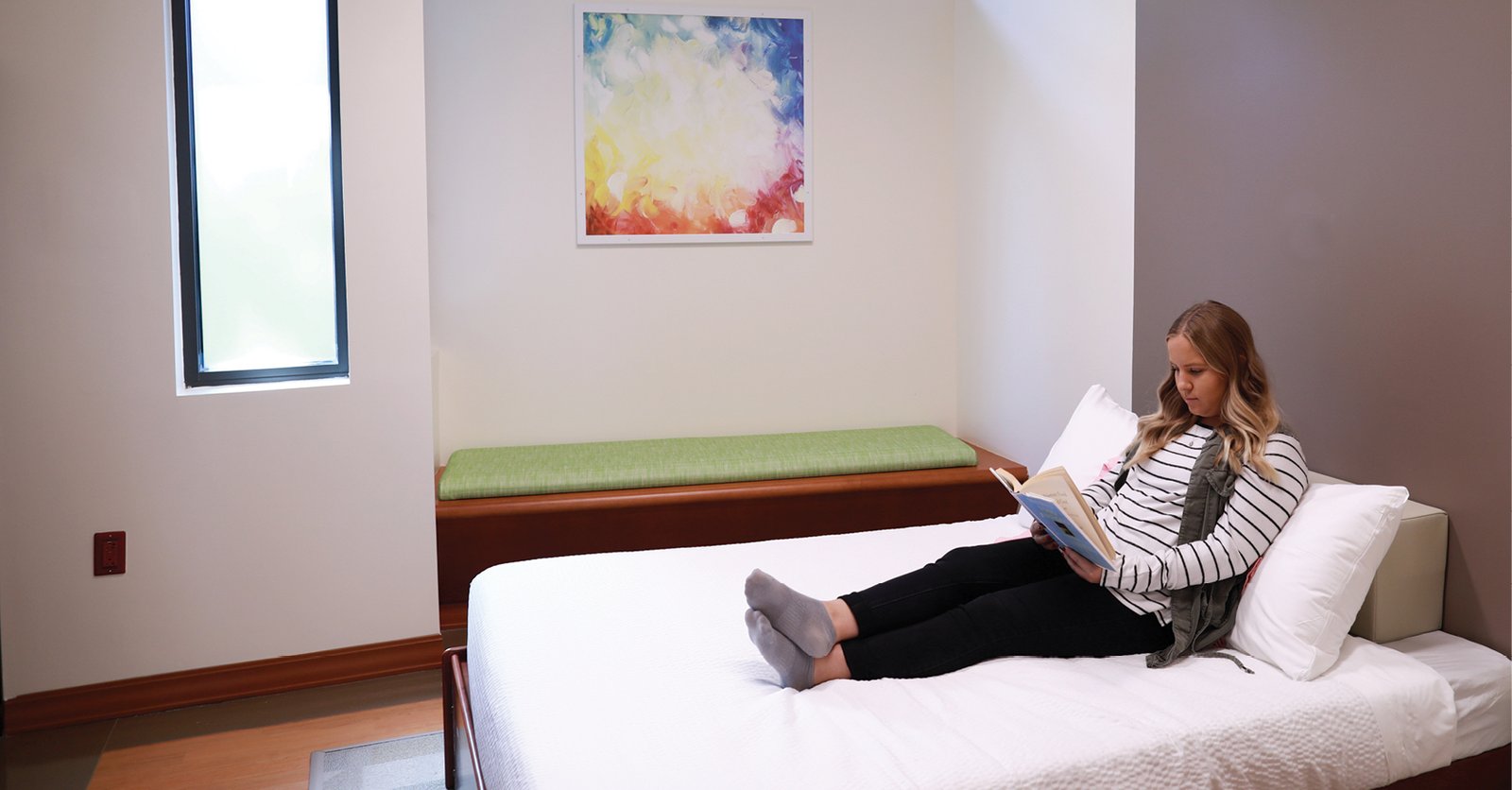Occasionally, mental health symptoms can present themselves abruptly and with intense severity. Seeking treatment can be daunting for someone uncertain about what to anticipate from the process, even if they recognize it as the appropriate course of action. The Lindner Center of HOPE’s outstanding care team helps patients and their loved ones through every phase of treatment, explaining the process thoroughly to ensure they are at ease and well-informed.
Dr. Margot Brandi, Medical Director at Sibcy House, emphasizes the positive impact of the care provided to individuals who seek in-patient or residential treatment at Lindner Center. She praises the residential admissions and intake departments for exceptional service, which includes offering residential unit tours and readily addressing questions.
People arrive at Lindner Center of HOPE for the first time through various channels. Some may come from outpatient services, while community providers or emergency departments refer others through the Access and Referral Center (ARC). At the ARC, nurses and social workers evaluate patients for admission. While most patients voluntarily seek admission, there are situations where involuntary admission is necessary.
“Patients could be suicidal, have attempted suicide, or have inflicted some sort of self-harm,” explains Dr. Danielle Johnson, Chief Medical Officer and a Fellow of the Psychiatric Association. “They may be severely depressed and experience a significant decline in their daily functioning, making it difficult to get out of bed, go to work or school, or take care of themselves or their families. Some may even have catatonic symptoms.”
Additionally, patients may experience manic episodes, which may lead to impulsive or risky behaviors. Some may even exhibit psychosis. It’s important to remember that in-patient care can be involuntary, while residential care is always voluntary.
A psychiatrist or psychiatric nurse practitioner assesses patients when they arrive. The nursing staff are available around the clock to administer medication, monitor the safety of patients, and ensure that they can perform daily living activities. Mental health specialists and technicians conduct individual and group therapy sessions, while social workers assist with discharge planning and communication with families.
Dr. Johnson emphasizes the importance of having therapeutic interactions with patients. “The ultimate objective is for them to reach a level of safety that allows them to be discharged, tolerate medication, and transition to a lower level of care,” she says. “This could include outpatient treatment, a partial hospitalization program, or transitioning to Williams House.”



Williams House is a facility that caters to patients who may have had some treatment but still require some time to prepare for their return home or school. These patients may no longer be experiencing the most acute symptoms, but they need more time to ensure that they are stable enough to continue with more psychologically challenging residential or outpatient care. Williams House also allows doctors to monitor how patients respond to medication while giving them ample time to understand their diagnosis.
“In-patient is not the place to figure out what happened but to make sure a patient is stable and safe,” Dr. Brandi notes.
Dr. William Hartmann, Williams House Medical Director, suggests that moving from in-patient care to residential care, like Williams House, can help slow down the clinical process and allow for better doctor-patient relationships.
“We carefully consider all the information available to draw useful conclusions,” he explains. “We then guide the person toward further treatment options that build on the progress they’ve already made.”
Hartmann advises patients and their families that the path toward improved health and wellness is not always straightforward, even after receiving acute care at Lindner Center of HOPE. It may require additional time and effort because not everything can be “fixed” immediately.
“Although people are improved when they leave in-patient care, that’s just the starting point,” Hartmann continues. “In-patient stay is really about getting a person to a point where they’re safe enough to work on what is a significant illness. It’s a gradual process that can feel very slow, but we’re looking for small gains along the way.”
Adds Hartmann, “While some urgent issues are dealt with during in-patient care, more work is required in the future through outpatient or residential treatment.”
The Williams House residential setting offers a unique integration of family and psychoeducation. This approach helps family members better understand their loved one’s challenges and promotes long-term stability, says Karly Danos, M.A., a licensed professional clinical counselor and certified career counselor who works as a residential therapist at Williams House.
“That’s what I love about Williams House,” she notes. “It gives us time to look at the patient’s support system and how we can improve it.”
Jason Bast, a licensed professional clinical counselor and family/group therapist at Lindner Center of HOPE, stresses the significance of addressing the patient’s support system during treatment. Without support system modifications, the patient may find themselves back in the same environment they left, posing a challenge to managing their symptoms.
“I used to do family therapy in residential, and often family members became frustrated because they felt powerless to help,” Bast recalls. Sometimes, when family members are uncertain about how to approach their loved one’s illness and treatment, the patient might misinterpret their uncertainty as the family being upset with them. However, educating everyone involved can help resolve this issue.
Bast says family involvement is also crucial for patients with psychosis, delusional hallucinations, schizophrenia, or bipolar disorder. It helps them receive better care, especially when they can’t communicate their needs or make sound decisions.
If someone is struggling with alcohol or substance abuse, they can receive detoxification services at Williams House. Lindner Center of HOPE also offers in-patient units for individuals with eating disorders. It’s crucial to understand that a patient may have a mix of illnesses — like bipolar disorder, depression or major anxiety disorders — and the unit they are admitted to depends on the severity of their condition.
It is common for patients to move from in-patient care to residential care. However, there may be occasions when they need to go back to in-patient care. This is normal and not a sign of failure on the patient’s part. Recovery can be challenging, and setbacks and triggers can occur. Having both options available on the same campus is beneficial because it makes logistics easier and treatment more seamless. Patients can walk down the hall instead of being transported to a different location.
That continuity of care is particularly beneficial to patients with personality disorders because they tend to engage in self-harm or suicidal ideation.
“Being able to have them go to in-patient means I can pop in to check on them,” says Danos. “We can keep them safe, and they can continually do therapeutic work with me. It’s convenient and helpful for the therapeutic process, especially when dealing with higher-severity disorders.”
Although psychopharmacology has its benefits, it can take some time for medication to take effect. That’s why it’s crucial to also incorporate psychotherapies such as Radically Open Dialectical Behavior Therapy (RO-DBT) in treating patients. RO-DBT is an evidence-based treatment developed specifically for problems of overcontrol.
Incorporating psychotherapy into a patient’s treatment protocol may include introducing and reintroducing the therapy, as necessary.
“An individual may not have been exposed to a particular psychotherapy, didn’t know they needed it or were not receptive to it in the past, but now they are,” says Hartmann. “Presenting the information in a new way can impact their recovery significantly.”


